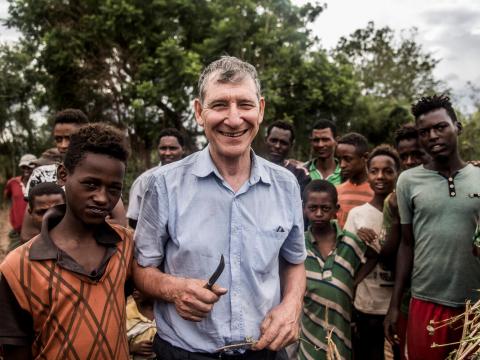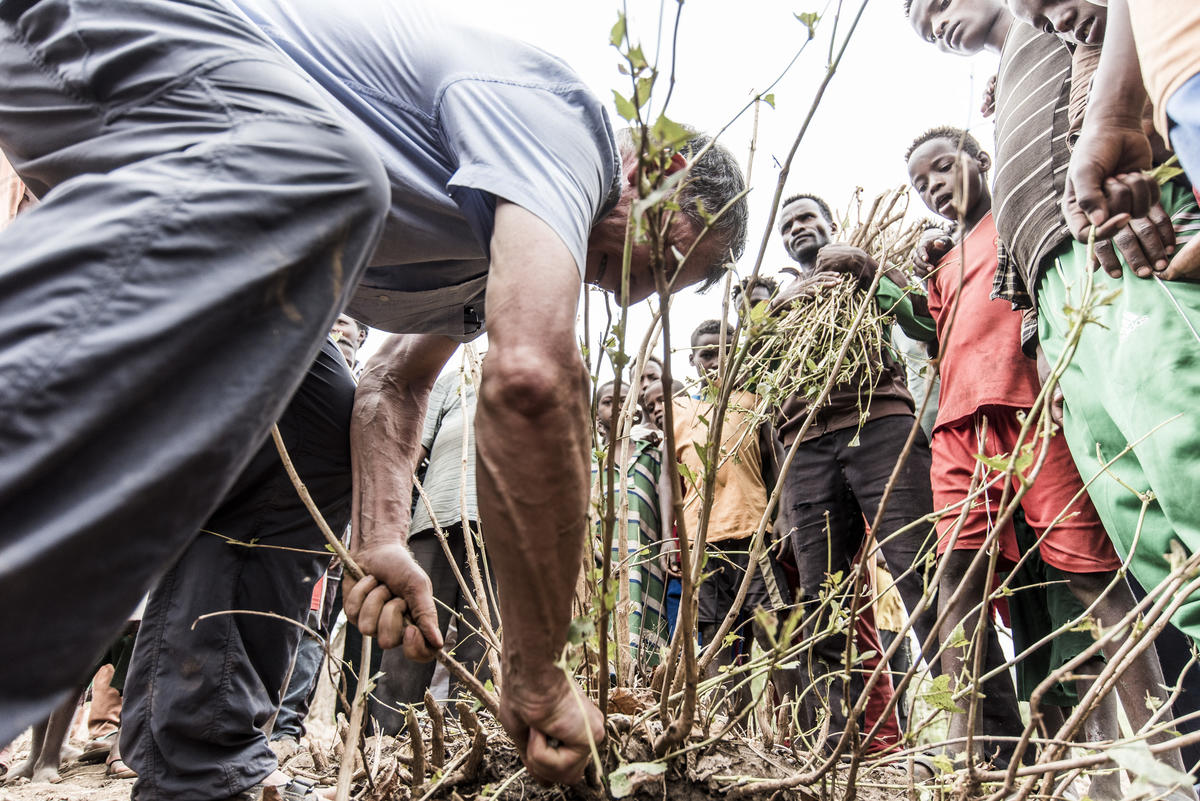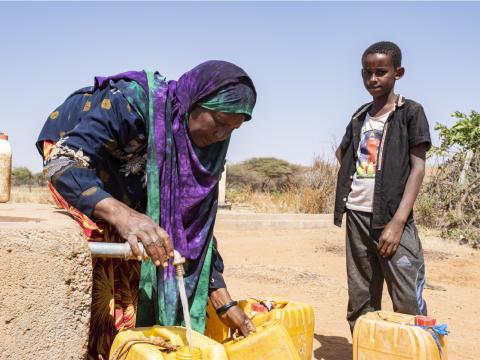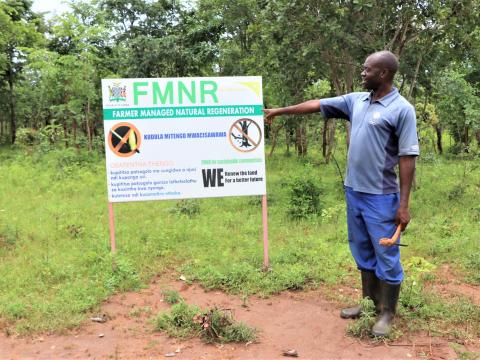
Unleashing the world's underground forests
By Tony Rinaudo, Senior Climate Action Advisor, World Vision Australia
In 1861, American diplomat and trailblazing conservationist George Marsh wrote:
“a territory larger than all Europe … has been entirely withdrawn from human use, or at best, is thinly inhabited … man’s actions have brought the face of the Earth to a desolation almost as complete as that of the moon … they are known to have been covered with luxuriant woods, verdant pastures, and fertile meadows.”
Marsh’s observations came at a time when the world’s population was around just one billion, before bulldozers and chainsaws were invented.
Today, our soaring population and unconstrained access to technologies and capital have allowed unthinkable rates of destruction. Marsh’s warning 160 years ago that humanity could destroy the Earth is true.
My life’s work has been in regeneration.
It’s taken me across Africa, parts of Asia and the Caribbean, where I’ve witnessed landscapes laid waste, or teetering on the edge of ecological collapse, barely able to support life.
Yet, there is life in these places. The people who live in these moonscapes are often the world’s poorest. Their livelihoods depend on the land. They live hand to mouth, subjected to extreme climate events, with no fallback, no way out. Degraded land cannot provide a livelihood.

The blessing of rainfall becomes the curse of flood, landslide and destruction. Because degraded land is incapable of absorbing and slowly releasing moisture, a dry spell becomes a major drought which means crop failure, loss of livestock, hunger, displacement, even death. Water shortage affects people, livestock and wildlife alike. Biodiversity retreats, and with it, community resilience and livelihood options.
It’s shocking enough to witness this destruction across the globe, let alone be among those experiencing it firsthand. Imagine how it would feel to be unable to feed, clothe or educate your children.
Every parent desires better futures for their children. Unable to deliver, they feel like failures; low self-esteem and a sense of resignation are common among the farming families I meet. People are trapped by poverty with no escape beyond migration. Competition over scarce resources and competition’s sinister cousin – conflict – increase.
The emotional impact of land degradation is as real and destructive as are the physical impacts. Without hope, people are unlikely to invest in their land and make necessary improvements – why bother, it’s all hopeless anyhow!
If all I did was observe this misery, I too would have given up long ago.
But 40 years of working with communities to reverse land degradation has convinced me that much can be done. There is hope. Landscapes and ecosystems are incredibly resilient and have enormous capacity to regenerate when given the chance. I’ve learnt that if we work with nature, instead of fighting it, nature will heal itself. Depending on the context, methods including Farmer Managed Natural Regeneration (FMNR), a regenerative approach I pioneered in Niger together with a group of farmers, combined with holistic grazing management and water-harvesting techniques can completely transform once degraded landscapes
Many barren landscapes have what I call an ‘underground forest’- a rich expanse of living tree stumps, tree roots and tree seeds. When burning, harvesting of ‘suckers’ (stems or re-growth) and grazing by livestock are stopped until the tree growth is strong enough to not be damaged, a forest can regenerate quickly and cheaply.
From Senegal to Somalia, India to East Timor and beyond, millions of farmers are learning about and applying principles which restore tree and grass cover with amazing results!
Bare, windswept plains are again becoming productive farmlands across millions of hectares in the Sahel, increasing and diversifying food production.
In parts of East Africa and Asia, springs flow as forest cover is restored. Grazing lands are healing even as fodder production soars with the restoration of trees. As landscapes return to health, so do the people – through better nutrition, increased incomes, and reduced conflict and migration. Along with this, just as real as regreened landscapes, comes hope.
I see hope, too, in the UN Decade on Ecosystem Restoration (2021-2030), which launches this Saturday (5 June ), World Environment Day. World Vision is proud to be a supporting partner of the decade which is a call to action to protect and restore the world’s ecosystems.
As a child-focused organisation, World Vision is responding to this call, recognising that it is children who are the most vulnerable to its negative impacts and have the most to lose by our inaction.
Things like FMNR help restore hope. It gives people agency, the courage to plan, invest and work towards creating a better future for themselves and their children with confidence.
We don’t need new technology anywhere near as much as simply pausing to understand how we got to where we are. We need humility to admit we got it wrong. Repentance is not fashionable, but unless we give up what we’ve been doing wrong and start doing what’s right, no amount of investment or technology will save us.
Back in 2012, I got lost in a forest in Humbo, Ethiopia, which six years earlier had been a wasteland. That beautiful, deep green forest was restored through little more than pruning. It is living proof that the best solutions are often simple.
Amazingly, there already exist many brilliant examples of inexpensive and sustainable land restoration approaches. The best of these involve communities whose livelihoods depend on the land – where they take part in decision-making and remedial action, and where they benefit from their actions.
I have hope. I work with nature and strive to give others the tools they need to restore and sustainably manage their landscapes. Wherever you are, whatever you do, I invite you to have hope and to similarly work with nature while striving to help others do the same.
In this way, we can regreen the globe.
Tony is the pioneer and leading world expert in FMNR. He received the 2018 Right Livelihood Award for demonstrating on a large scale how drylands can be greened at minimal cost, improving the livelihoods of millions of people and especially improving the lives of women and children. His goal is to see degraded land restored, using FMNR, in 100 countries by 2030. FMNR is a winner of the 2019 World Future Council's Agroecology Best Practice award, and Tony was awarded an Order of Australia (AM) for services to Conservation in 2019.
More information:
Farmer Managed Natural Regeneration | Economic Development | World Vision International (wvi.org)
Climate Change | Sector | World Vision International (wvi.org)
Tony Rinaudo - The Forest Maker | World Vision Australia
UN Decade on Ecosystem Restoration

